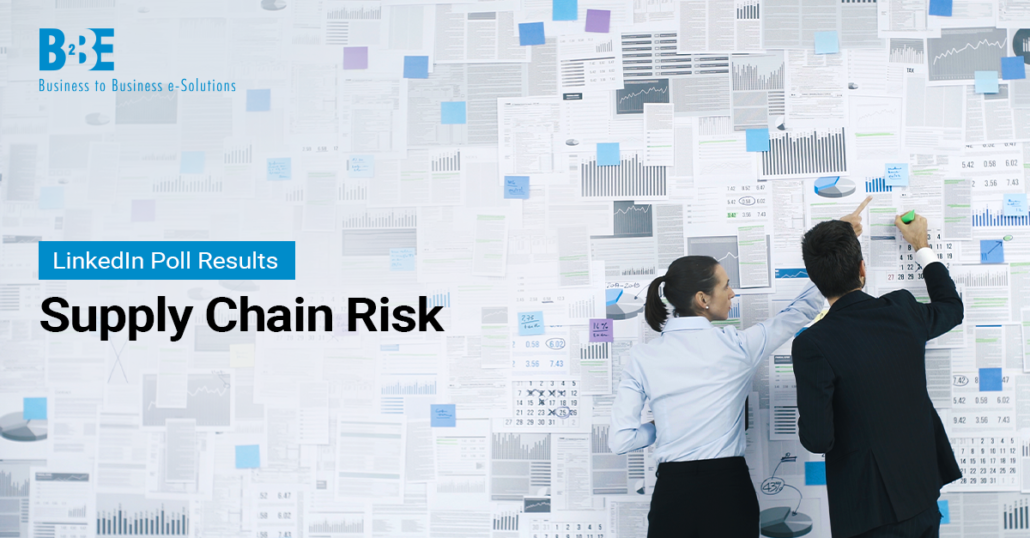Organisations of all sizes rely on complex supply chains to keep their operations running smoothly. However, these intricate networks are also susceptible to a wide range of risks. These risks can disrupt the flow of goods and services, lead to financial losses, and damage a company’s reputation. Identifying and mitigating supply chain risk has become a critical concern for business leaders across all industries. With that in mind, this blog will explore one important question: What supply chain risk do you consider the biggest threat to your business?
Poll results
In our most recent LinkedIn poll, we asked our social media followers: what supply chain risk do you consider the biggest threat to your business?
Supply chain risk: what we found
Economic uncertainty – 55%
Economic uncertainty was identified as the biggest supply chain risk by a majority of respondents. 55% of those surveyed selected it as their top concern.
This result is not surprising given the current global economic landscape. Economic uncertainty has been shaped by a range of factors including geopolitical tensions, trade wars, and the ongoing COVID-19 pandemic. These challenges have created a high degree of uncertainty and volatility in supply chains. It’s now much more difficult for businesses to predict demand, plan inventory, and manage costs effectively. Economic uncertainty can also lead to sudden changes in consumer behaviour, supply chain disruptions, and shifts in global trade patterns. All of which can have a significant impact on a business’s bottom line.
As a result, businesses need to proactively identify and manage economic risks. Building more agile and resilient supply chains can help to achieve this. As well as staying informed about global economic trends, and developing contingency plans for potential disruptions.
On-going labour shortages – 27%
The poll also found that on-going labour shortages were a significant supply chain risk, with 27% of respondents identifying it as their top concern.
The on-going labour shortage has been a major challenge for many industries, particularly in the wake of the COVID-19 pandemic. The pandemic has disrupted global supply chains, leading to factory shutdowns, travel restrictions, and reduced production capacity. As a result, many businesses are struggling to find enough workers to meet demand. Labour shortages can lead to delays in production and delivery, increased costs, and decreased customer satisfaction.
To mitigate this supply chain risk, businesses can focus on improving worker retention and training. As well as investing in technology and automation to reduce reliance on human labour.
Climate change – 9%
Climate change was identified as a significant supply chain risk by 9% of respondents. This places it in the joint bottom position with ‘other’ risks.
Although climate change is increasingly recognised as a major global challenge, it is often not seen as an immediate supply chain risk. However, the impact of climate change on supply chains is becoming more evident, with extreme weather events such as floods, droughts, and storms increasingly disrupting production, transportation, and logistics. Climate change can also lead to supply chain disruptions due to regulatory changes, resource scarcity, and shifts in consumer demand.
To manage the risks associated with climate change, businesses can focus on developing sustainable supply chain practices. This could include reducing carbon emissions, improving energy efficiency, and using renewable resources.
Other – 9%
The remaining 9% of respondents identified “other” as a significant supply chain risk, placing it in the joint bottom position with climate change.
This response may suggest that there are other risks not covered in the poll that businesses are concerned about. These could include cybersecurity, geopolitical instability, or natural disasters. The term “other” is quite broad and could refer to a wide range of supply chain risks that are specific to a particular industry or business. It could also indicate that some respondents did not feel that the risks listed in the poll accurately reflected their concerns.
To mitigate risks that fall under the “other” category, businesses need to conduct a thorough risk assessment and identify potential risks that are specific to their operations. This could involve analysing supplier performance, monitoring market trends, and staying informed about changes in the regulatory landscape.
More information
B2BE’s experience in the supply chain sector allows our customers to build, expand and adapt successfully, enabling greater effectiveness. To engage with B2BE and offer feedback on what matters most to you and your business, make sure to follow us on LinkedIn and across social media. You can also vote in our latest LinkedIn poll. If you’d like to discuss your supply chain strategy, get in touch with us.
